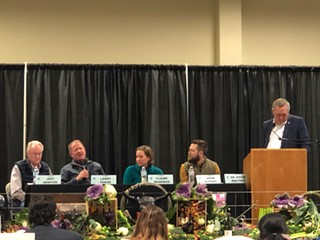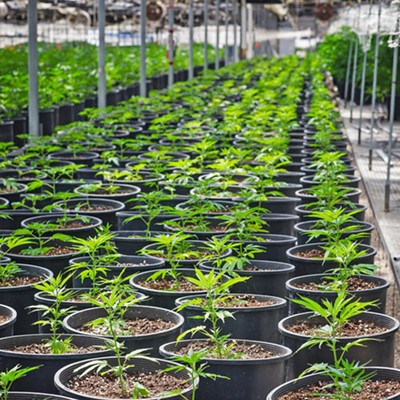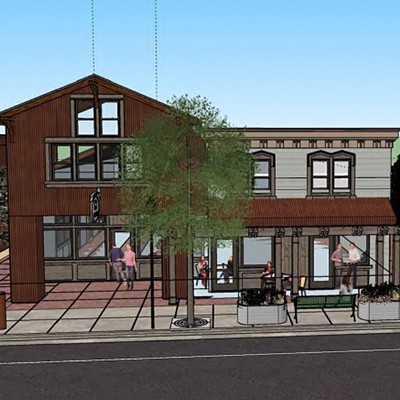Labor shortages and government regulations tied to groundwater usage continue to hinder local farmers, but technological advancements could ease some of these concerns, according to a panel of agriculture experts who spoke at a recent event in Santa Maria.
The panel met as part of a forum the local nonprofit Econ Alliance hosted at the Santa Maria Fairpark on Feb. 6. Along with the panel, the forum—titled Growing Possibilities—included presentations from U.S. Department of Agriculture Deputy Secretary Stephen Censky, California Department of Food and Agriculture Secretary Karen Ross, and Santa Barbara County Agriculture Commissioner Cathy Fisher.
Censky touted new federal trade deals that he said will benefit local farmers, while Ross explained how the state is attempting to address climate change and the role farming can play in reducing greenhouse gas emissions. Fisher touched on some local issues, like beehive theft, and recapped the county’s 2018 crop report, which was released last July.
The panel of local agriculture experts—representing the wine, cannabis, and row crop industries—picked up where Fisher left off: focusing on local problems.
Claire Wineman, president of the Grower-Shipper Association of Santa Barbara and San Luis Obispo Counties, said the ongoing labor shortage remains the most significant challenge for members of her organization. She said that farmers try to pay more than minimum wage to attract workers, but it’s difficult to compete with states like Arizona where the cost of operating a business is cheaper.
“We continue to experience an ongoing labor shortage, and that means people haven’t been able to capitalize on these opportunities,” Wineman said. “There’s product people can’t harvest because there’s not enough [workers] to be able to harvest that.”
Larry Ferini, president of Rancho Laguna Farms and a county planning commissioner, agreed that labor is a challenge, but he said that it’s tied to the broader issue of the cost of housing in the county. And this doesn’t just include the need for more government-funded affordable housing projects, he said, but rather ways to reduce the cost of housing across the board.
In addition to these labor challenges, the panel agreed that increasingly stringent government regulations are affecting their respective industries, with the top concern being rules governing water usage.
Wineman said a new set of regulations the Central Coast Regional Water Quality Control Board is considering includes changes to how farmers use groundwater, which will make operating difficult. This agricultural order is a follow-up to a previous order, which the board approved in 2017 and is set to expire on January 31, 2021. This new order must be approved before that expiration date.
Ferini called the water board’s proposed new order “draconian” and said, “it is completely insensitive to agriculture.”
“Farmers are now less than 1 percent [of the population], and we’re trying to provide food for 100 percent of the people that live here, of which 90 percent live in urbanized communities,” Ferini said. “So we have people who are completely out of touch.”
To address both of these challenges, farmers will have to rely more on technology that automates farming to make up for the lack of available labor while also helping them become more effective with their water usage, the panel members said.
Jeff Newton, president and CEO of Coastal Vineyard Care, said the wine industry is moving toward drip irrigation, which waters crops slower and more efficiently than sprinklers. The company is also leaning on machines more to remove leaves and prune grape vines, as well as to harvest the fruit.
Cannabis farmer and Central Coast Agriculture CEO John De Friel said he envisions that this reliance on technology will only increase as regulations tighten.
“The future of farming is a high technology space,” De Friel said. “And with all the extra regulations coming on and small margins, there’s no room for wastefulness.”
De Friel predicts that, in the future, farmers will have to emphasize precision and develop methods to further that goal. This includes maximizing seed breeding programs that produce better crops with higher yields or the ability to adapt to different conditions.
“The future farm is going to be run by accountants and engineers, and this will be treated like biotechnology in Silicon Valley,” De Friel said. “I think you’ll see a lot of the Central Coast … will have the opportunity to reframe the vision of agriculture and put an emphasis on precision.”
Ferini agreed that technological advancements in recent years have made farming more efficient, but he isn’t yet ready for the machines to take over.
“In 10 years, I can’t really tell you what it’s going to look like,” Ferini said. “Our business will continue to change, but … this is a very unique area, and it’s highly adaptable to many crops. So as long as we have the human resources, we can accomplish that change and keep this business thriving and healthy.”
Reach Staff Writer Zac Ezzone at [email protected].













